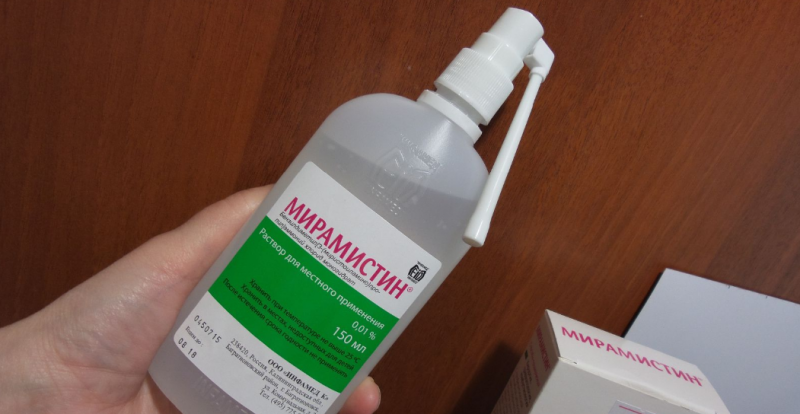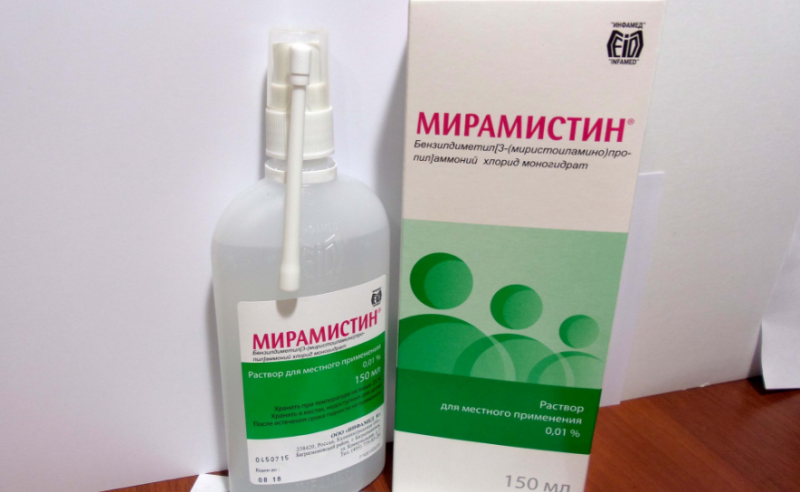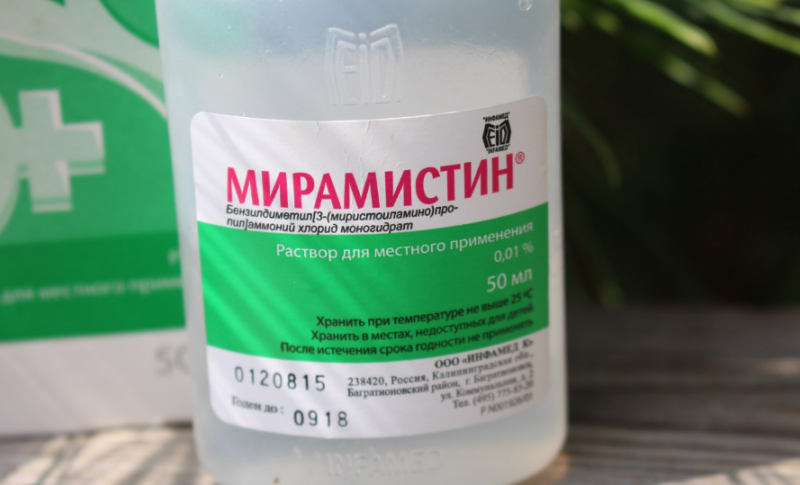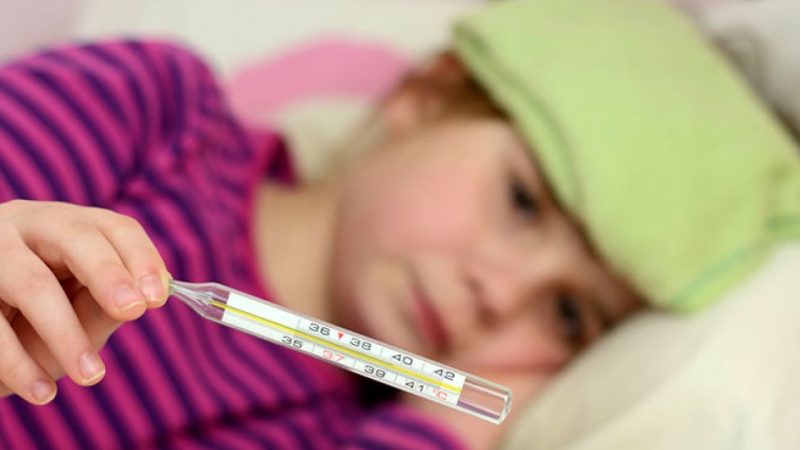A popular remedy quickly relieves inflammation in uncomplicated diseases of the skin and ENT organs. Miramistin liquid for children is most often used in diluted form. The drug is safe with proper use, fights microbes and stimulates the regeneration process.
Material Content:
The composition of the drug
The drug is produced on the basis of benzyldimethyl [3- (myristoylamino) propyl] ammonium chloride, monohydrate. Few people remember by heart this unpronounceable name of the active substance (DV). But many people know the trade name of an effective antiseptic - Miramistin.
The complex ammonium salt is dissolved in purified water. There are no other components. The solution in plastic bottles of 100 and 200 ml looks like a clear liquid, does not have a specific smell, foams with vigorous shaking.
The taste of the solution is neutral, which is important for use in diseases of the oral cavity and throat in children.
Spray "Miramistin" is the same solution with a concentration of DV of 0.01%. The product is available in 50 and 150 ml plastic bottles. A spray nozzle in the form of a tube with a nozzle can be sent to the nasal passages, to the tonsils and the posterior pharyngeal wall. The spray is intended for the treatment of ENT diseases and infections of the oral cavity. The cost of a bottle of 50 ml - from 200 rubles, 150 ml - from 360 rubles.
pharmachologic effect
The drug is effective against viruses, bacteria and fungi. The tool has strong antiseptic and anti-inflammatory properties.“Miramistin” with a runny nose of viral origin, prevailing in young children, is able to suppress the activity of viral particles.
Streptococci and staphylococci are the most sensitive to the drug - typical pathogens of bacterial tonsillitis, otitis media, sinusitis. In relation to the common representatives of these groups, Miramistin exhibits a bactericidal effect. Also, the drug is active against Klebsiella, chlamydia, E. coli, gonococcus.
Thanks to the use of Miramistin, inflammation decreases, the risk of purulent complications decreases, and recovery comes faster.
The tool destroys the causative agents of candidal stomatitis, microsporia of the skin and other fungal diseases. When applied to wounds, Miramistin not only disinfects, but also stimulates local immunity.
An important advantage of Miramistin for use in pediatrics is hypoallergenicity. Usually, a dilute solution is used to treat the common cold, sore throat and stomatitis in children, which does not cause mucosal irritation.
Why is Miramistin prescribed to a child?
With conjunctivitis, you can rinse your eyes, with rhinosinusitis - instill "Miramistin" in the nose of a child. The spray is often used to treat acute and chronic diseases of the oropharynx, nasal cavity, paranasal sinuses. The solution is used to gargle, inhalation, instill in the ears, treat affected areas of the skin.
What diseases of children are treated with Miramistin (topically and externally):
- diaper rash, dermatomycosis, streptoderma, eczema, herpes;
- rhinitis, sinusitis, otitis media of viral and bacterial etiology;
- acute and chronic pharyngitis, tonsillitis;
- burns (thermal, solar, chemical);
- candidal stomatitis, gingivitis;
- SARS, the flu.
The safety of applying the drug to the mucous membranes and skin has been proven in clinical trials conducted in Russia. Miramistin is officially allowed to be used in pediatrics and ENT practice. It is recommended to strictly observe the dose, adhere to the course of therapy prescribed by the doctor, do not abuse the independent use of a strong antiseptic.
Instructions for use for children
Dosage, method of using an antiseptic, the number of treatments depend on the diagnosis and age of the small patient. Adults may not dilute Miramistin for gargling, inhalation. In the antiseptic liquid intended for the treatment of a small child, the same volume of chilled boiled water is preliminarily added.
- In case of nasal congestion and rhinitis, carefully spray the spray in the nasal passages. Perform the procedure 3-4 times a day. If a small child has a runny nose, then it is better to instill the diluted solution into the nose with a disposable syringe without a needle.
- Infants are treated with the cheek mucosa with a four-fold bandage moistened with a solution of this antiseptic (1: 1). With sucking movements, fluid enters the inflamed tonsils and posterior pharyngeal wall.
- If a child older than 3 years is able to rinse the oral cavity and pharynx, then they give 10-15 ml of undiluted Miramistin at a time, make sure that the baby does not swallow the liquid. The duration of treatment is from 3 to 10 days.
- Miramistin Spray has been used for irrigation of tonsils, oral mucosa, and pharyngeal wall since 3 years. Spraying allows you to economize on medicine, prevents ingestion of fluid. The solution through a thin elongated nozzle enters the inflamed areas in the form of tiny drops, immediately begins to act. For one click, 4 ml of antiseptic is applied.
Immediately before treatment, the child is asked to hold his breath while spraying the spray in the oral cavity.
Sequencing:
- Open the solution bottle.
- Attach spray nozzle to neck.
- A few presses from above activate the sprayer.
- Treat inflamed cheek mucosa (with stomatitis), pharynx (with pharyngitis), palatine tonsils (with angina).
- After the procedure, do not drink or eat for half an hour.
- Treat throat 4 or 5 times a day.
To carry out inhalation with Miramistin, 4 ml of a liquid antiseptic with saline solution is mixed in a nebulizer (1: 2). The child is allowed to inhale the medicine for 5 to 15 minutes. The procedure is recommended 3 times / day. Adolescents over 12 years of age are not diluted with Miramistin for inhalation.
With external otitis media, inflamed, infected areas of the skin are treated with a liquid antiseptic. The solution is instilled into the sore ear with otitis media. Children over 3 years old - 1 drop in the morning, afternoon and evening, for adolescents - 2 drops every 4-5 hours. It is possible to introduce at night the flagellum gauze moistened with “Miramistin” into the auditory meatus. The course of treatment is up to 10 days.
It is allowed to dig in only if the integrity of the eardrum is not broken. Otitis may be accompanied by the formation of pus in the middle ear cavity and the “fusion” of the membrane. In this case, pus flows out of the ear canal, hearing is impaired or completely lost.
Drug interaction
If an infectious disease is accompanied by severe fever, intoxication, complications, then the use of an antiseptic alone is not enough. Miramistin will not cope alone with advanced inflammation. The use of an antiseptic on the recommendation of a doctor is supplemented with antibiotic therapy. Also, the drug enhances the effect of the use of antifungal agents.
Contraindications, side effects and overdose
The instructions for use mention only one strict restriction on the use of Miramistin - an antiseptic solution is contraindicated in case of hypersensitivity to ammonium salt in the composition of the drug.
Occasionally, after local and external use of the liquid, symptoms of an allergic reaction are observed. There is burning sensation and itching of the skin, pink blisters (urticaria) appear. Quincke's edema even more rarely occurs - the so-called enlargement of a part of the face or body. Swelling of the eyelid or ear can occur after instillation, and the tongue, lips - after irrigation of the oral cavity.
The drug, applied to the skin, with the appearance of burning and blisters need to be washed off. If you used a spray, a solution for irrigation of the throat, then you need to rinse your mouth. Cases of overdose are unknown. Miramistin does not have a systemic effect, since it practically does not penetrate the mucous membranes and skin, and is not absorbed into the blood.
Antiseptic analogs
Miramistin is one of the few antiseptics allowed for children under one year old. The same active ingredient is part of the Okomistin eye, ear and nasal drops. This drug is prescribed only from the age of 18.
The solution "Chlorhexidine" is often called the analogue of "Miramistin." However, in these preparations, only the form of release and the mechanism of action coincide.
"Chlorhexidine" contains another DV, used primarily for skin disinfection. Undiluted drug can not be processed mucous membranes.
Miramistin has an antimicrobial, immunostimulating, anti-inflammatory and healing effect; it is not absorbed into the systemic circulation. This is a universal, safe antiseptic, more modern than chlorhexidine or other group analogues. Miramistin does not have a toxic and local irritant effect if used correctly.



















